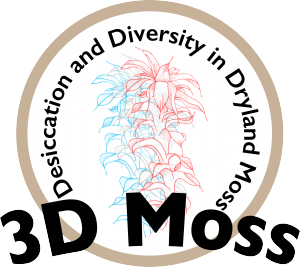NSF Award for Collaborative Research:
“Desiccation and Diversity in Dryland Mosses”
This website outlines the research and associated activities for a collaborative project supported by the US National Science Foundation through the Dimensions in Biodiversity Program. 
Snapshot of the Project
Mosses are the second most diverse group of land plants and they play important ecological roles in terrestrial ecosystems. Since an early divergence from other land plants some 450 million years ago, mosses took a different path than vascular plants to solving the challenges to survival and reproduction posed by terrestrial environments. One important trait that is well developed in mosses is the capability of drying without dying, known as desiccation tolerance (DT). This critical trait allows many mosses to survive and reproduce even in drylands, and may be the key to their survival in the face of current, rapid climate change. Syntrichia is a large and diverse genus of mosses occurring worldwide and generally in dryland habitats. Despite their dominance in certain communities such as biological soil crusts, surprisingly little is known about the drivers of biodiversity in this clade.

